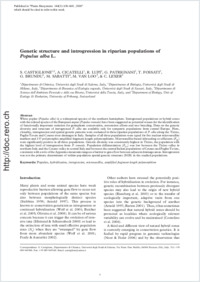Genetic structure and introgression in riparian populations of Populus alba L.
- Castiglione, S. Dipartimento di Chimica, Universitagrave degli Studi di Salerno, Italy - Dipartimento di Biologia, Universitagrave degli Studi di Milano, Italy
- Cicatelli, A. Dipartimento di Chimica, Universitagrave degli Studi di Salerno, Italy
- Lupi, R. Dipartimento di Biologia, Universitagrave degli Studi di Milano, Italy
- Patrignani, G. Dipartimento di Biologia, Universitagrave degli Studi di Milano, Italy
- Fossati, T. Dipartimento di Biologia, Universitagrave degli Studi di Milano, Italy
- Brundu, G. Dipartimento di Botanica ed Ecologia vegetale, Universitagrave degli Studi di Sassari, Italy
- Sabatti, M. Dipartimento di Scienze dell'Ambiente Forestale e delle sue Risorse, Universitagrave della Tuscia, Italy
- Loo, M. van Department of Biology, Unit of Ecology and Evolution, University of Fribourg, Switzerland
- Lexer, Christian Department of Biology, Unit of Ecology and Evolution, University of Fribourg, Switzerland
-
2010
Published in:
- Plants Biosystems. - 2010, vol. 144, no. 3, p. 656-668
English
White poplar (Populus alba) is a widespread species of the northern hemisphere. Introgressed populations or hybrid zones with the related species of the European aspen (Populus tremula) have been suggested as potential venues for the identification of functionally important variation for germplasm conservation, restoration efforts and tree breeding. Data on the genetic diversity and structure of introgressed P. alba are available only for sympatric populations from central Europe. Here, clonality, introgression and spatial genetic patterns were evaluated in three riparian populations of P. alba along the Ticino, Paglia-Tevere and Cesano river drainages in Italy. Samples of all three populations were typed for five nuclear microsatellite markers and 137 polymorphic amplified fragment length polymorphisms. Microsatellite-based inbreeding co-efficients (FIS) were significantly positive in all three populations. Genetic diversity was consistently highest in Ticino, the population with the highest level of introgression from P. tremula. Population differentiation (FST) was low between the Ticino valley in northern Italy and the Cesano valley in central Italy and between the central Italian populations of Cesano and Paglia-Tevere, consistent with a role of the Appenine mountain range as a barrier to gene flow between adjacent drainage areas. Introgression was not the primary determinant of within-population spatial genetic structure (SGS) in the studied populations.
- Faculty
- Faculté des sciences et de médecine
- Department
- Département de Biologie
- Language
-
- English
- Classification
- Biological sciences
- License
- License undefined
- Identifiers
-
- RERO DOC 20774
- DOI 10.1080/11263504.2010.496188
- Persistent URL
- https://folia.unifr.ch/unifr/documents/301768
Statistics
Document views: 102
File downloads:
- lex_gsi.pdf: 136
